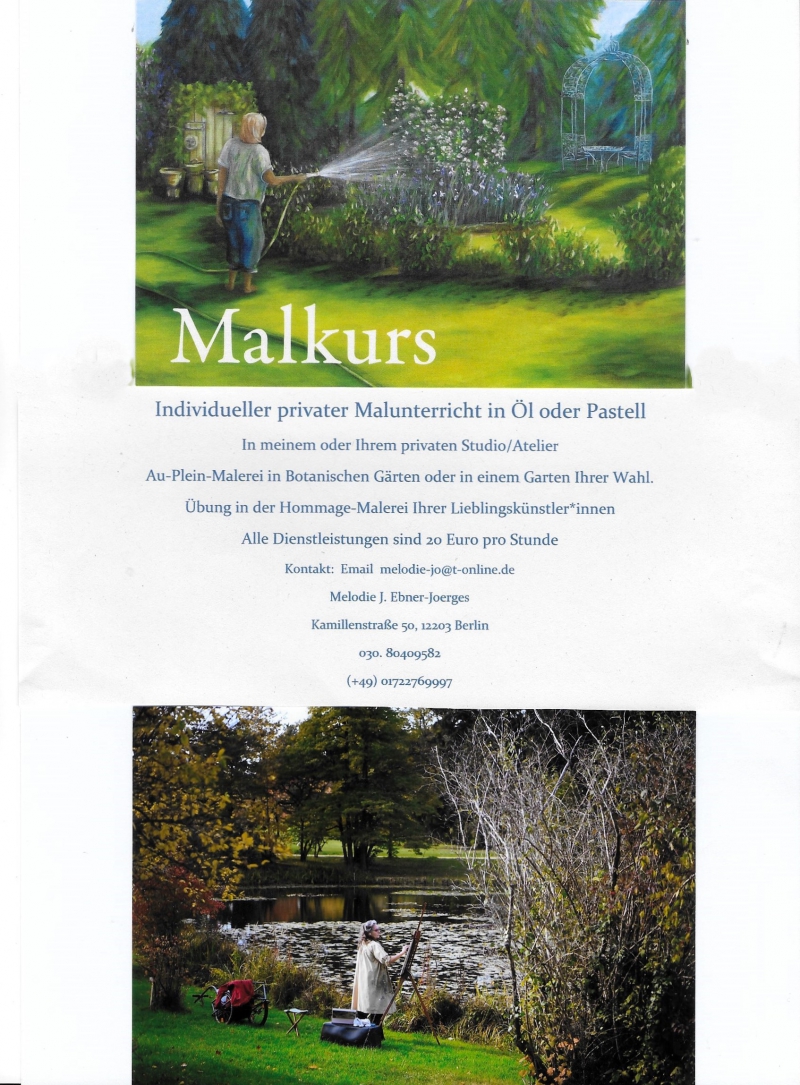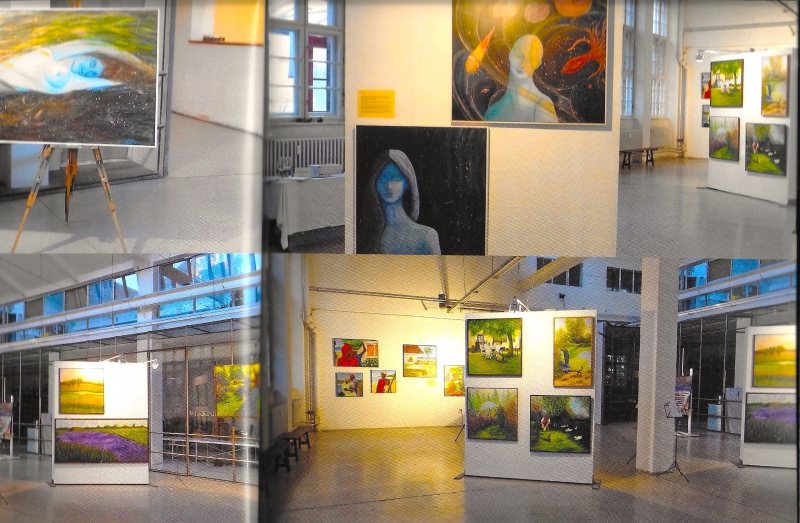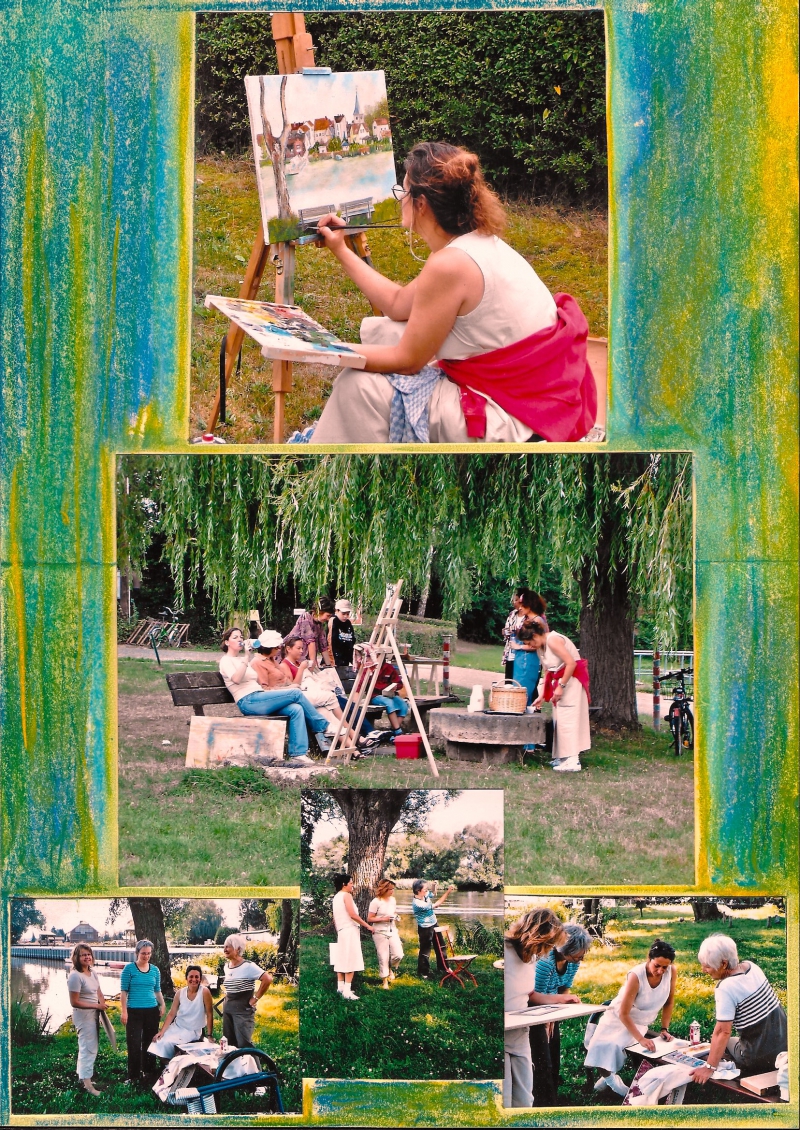
News
Melodie J Ebner

This is one example of a Hommage to Monet Landscape in Giverny. With my students we approach the painting from a master painting step-by-step understanding the complexity of the artists colours and composition. A painted interpretation of an Artist is allowed and can also be purchased as long as the painting is not signed with the original artists name and behind the canvass it is clearly marked, "Hommage to the original Artist".

This
Triptych was produced in 2019 when I broke my right shoulder and arm. I lost all movement from my fingers, hand to
the upper arm and was told I may never retrieve the movement again. I thought my days as a painter was over. The idea of painting out my fear and healing
my arm myself developed when I tried to draw with my left arm. I discovered I could indeed use my left arm
quite well and in doing so created small studies of the human body. Di Vinci’s drawings were my reference. The triptych is a collage of 38 left to right
drawings. The middle piece is an Homage
to Di Vinci, self-portrait. After
finishing this project, I created several other works and my arm was healed
thereafter.
Currently I offer painting lessons for anyone who wishes to use this medium to heal. I designed a creative program focused on body and mind, especially depression. Simply contact me through email and we can make an appointment.



The Wandering Artists
A story about an artist and the Kunsthof Bahnitz
In 1995 I was working with an international group of twenty-two European artists in wonderful factory ateliers in Amsterdam, Holland, when we were pushed out of our working spaces due to a massive population influx which precipitated a housing crisis for all. Needing a new space to create, the group decided to travel to Berlin. We had heard from different artist circles that in the former East Berlin district Mitte, artists’ spaces were available. There, dilapidated, large, old Berliner flats were abundant and extremely cheap. So, we packed up materials and belongings and headed East from Amsterdam to Berlin. What we found was a large city that had no idea what the concept of freedom of movement in the European Union meant and therefore had no established protocol for us artistic wanderers. Eventually, we all gained permission and so our `artists of Mitte’ journey began.
In 1997 a large artists’ picnic was arranged in another artists’ photography and film warehouse in the Tiergarten district which doubled as a graveyard for Berlin’s architectural ruins. It was here, amongst some fifty other guests, that I met my partner for life. His name was Professor Dr. Bernward Joerges, originally hailing from Stuttgart, Germany. We shared interests in architecture, sociology, photography, film and most importantly, the collaboration of art and science. This became the bedrock of a personal and creative partnership that would last over twenty-five years.
By the turn of the century the rebuilding of Berlin was in full swing, and our building was sold to high-stakes realtors, who eventually, like in Amsterdam, pushed everyone out �" it was time to move again. My now husband Bernward and I embarked on new adventure, to find a space to paint for me and to create an architectural project for him.
During the annual oyster and wine party sponsored by Professor Christoph Langhof in his Charlottenburg, now Upper West, Langhof Studio für Architektur-Design Berlin, we serendipitously met Beate Schubert, a documentary film director from Berlin. We talked with her about our search for a commercial property to invest in and our plans to renovate and start an artist residency. She then told us that she had just invested in a village called Bahnitz, in Havelland and that she was also interested in starting an artists’ residence and community there. This now became a very interesting proposition, because although we had heard of Bahnitz through family members, knowing someone that shared our idea and was planning the same, gave us the impetus to visit Havelland and investigate the new spaces and their possibilities.
Indeed, the old Gäststätte/Pub and Post building was for sale, and we soon began the process of purchasing the property. Community acceptance was important to us, so we first asked the mayor, Herr Schulze, if our idea would be welcomed by the village residents. After reassuring the mayor that artists would not be running around naked doing very silly things and explaining what kind of art we would be producing, he agreed to the project. Thus, the long process of renovating and creating the “Kunsthof Bahnitz” had begun. The mayor and his entire family, the Schulze family, amongst others, were of the greatest help to us during the entire process of building and managing the Kunsthof.
From 2000 to 2014 we created a space where thousands upon thousands of German and European visitors came to Bahnitz for annual art shows, paintings, concerts, literature festivals, film, photography, sculpture, culinary adventures and much more. The Kunsthof was featured in films, books and hundreds of journalists’ articles. Bahnitz had up to twelve artists at one point who had moved into the village and enjoyed the new-found spaces. It was a success and the best work my husband and I had ever achieved up to this time.
It is said, that in life everything changes every ten years, and we had produced a gem of a project, a painted masterpiece in fourteen years. Due to my husband’s failing health we had the painstaking decision to leave our project and move back to Berlin. The Kunsthof was sold in 2014 to another artist with great hopes that it would endure the test of time. Our wish was simply that the project would carry on into the future, changing with each new occupant/owner who would then leave their own impression, so the story continues…
Melodie J. Ebner-Joerges
Co-writer Jessica Rohm
2025 Berlin